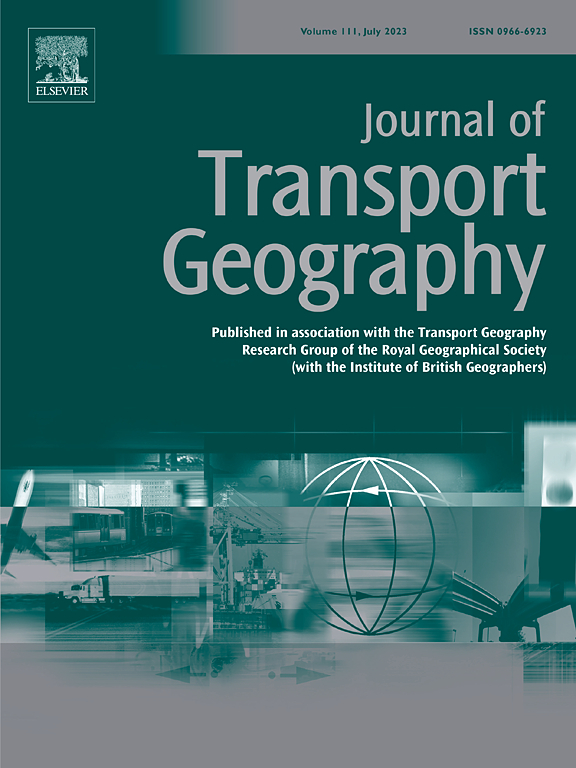超越性别中立的交通规划:制定多维尺度,评估一种出行方式是否适合妇女
IF 6.3
2区 工程技术
Q1 ECONOMICS
引用次数: 0
摘要
女性在城市交通系统中面临着独特的挑战和制约,但在交通研究中,性别流动性及其对女性模式选择行为的影响在很大程度上被忽视了。本文旨在开发一个多维尺度来评估女性出行模式(STMW)的适用性,重点是共享出租车系统。拟定的STMW量表包含七个维度:对虐待的恐惧、骚扰经历、个人对骚扰的感知、自我形象、家庭规范、旅行环境和条件以及卫生问题。通过综合分析这些因素,本研究旨在为交通政策制定者提供有价值的见解,以促进包容和公平的交通规划策略。STMW量表是通过三项研究开发和验证的。研究1 (n = 330)侧重于量表开发,利用探索性因素分析来确定影响女性对旅行方式适用性看法的潜在因素。研究2 (n = 339)采用验证性因子分析对量表的七因子结构进行验证。最后,研究3 (n = 421)考察了STMW因素与旅游满意度量表和社交焦虑问卷等心理测量指标之间的关系。本文还探讨了STMW因素与婚姻状况、年龄、模式选择行为等背景变量之间的关系。验证研究的结果为STMW量表的结构效度提供了支持证据,表明其作为测量工具的可靠性和稳健性。为了促进妇女的流动性和社会参与,特别是在传统和父权结构的环境中,至关重要的是要了解妇女如何看待不同交通方式的适宜性。本文的讨论强调了拟议规模对交通规划和政策的影响。本文章由计算机程序翻译,如有差异,请以英文原文为准。
Beyond gender-neutral transportation planning: Developing a multidimensional scale for assessing the suitability of a travel mode for women
Women face unique challenges and constraints in urban transportation systems, yet gendered mobility and its impact on women's mode choice behavior have been largely overlooked in transportation studies. This paper aims to develop a multidimensional scale that evaluates the suitability of a travel mode for women (STMW), focusing on shared taxi systems. The proposed STMW scale incorporates seven dimensions: fear of abuse, experiences of harassment, individual perception of harassment, self-image, family norms, trip environment and conditions, and hygiene concerns. By comprehensively analyzing these factors, the study aims to provide transportation policymakers with valuable insights for promoting inclusive and equitable transportation planning strategies. The STMW scale was developed and validated through three studies. Study 1 (n = 330) focused on scale development, utilizing exploratory factor analysis to pinpoint underlying factors shaping women's perceptions of travel mode suitability. Study 2 (n = 339) used confirmatory factor analysis to validate the seven-factor structure of the scale. Finally, Study 3 (n = 421) examined relationships between the factors of STMW and established psychological measures, such as Satisfaction with Travel Scale and Social Anxiety Questionnaire. This paper also explored the relationships between STMW factors and background variables, including marital status, age, and mode choice behavior. The findings of the validation studies provided evidence supporting the structural validity of the STMW scale, indicating its reliability and robustness as a measurement tool. To promote women's mobility and participation in society, particularly in settings with traditional and patriarchal structures, it is crucial to understand how women perceive the suitability of different modes of transportation. The paper's discussion emphasizes the implications of the proposed scale for transportation planning and policy.
求助全文
通过发布文献求助,成功后即可免费获取论文全文。
去求助
来源期刊

Journal of Transport Geography
Multiple-
CiteScore
11.50
自引率
11.50%
发文量
197
期刊介绍:
A major resurgence has occurred in transport geography in the wake of political and policy changes, huge transport infrastructure projects and responses to urban traffic congestion. The Journal of Transport Geography provides a central focus for developments in this rapidly expanding sub-discipline.
 求助内容:
求助内容: 应助结果提醒方式:
应助结果提醒方式:


